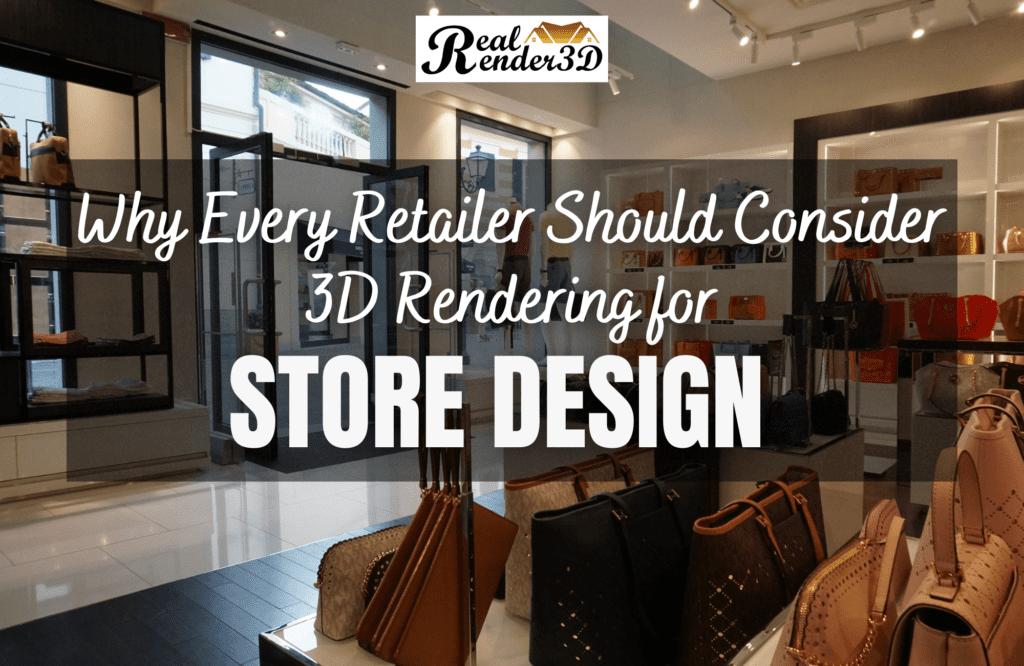Introduction
In the dynamic world of retail, staying ahead of design trends and technology is crucial for attracting customers and optimising store performance. 3D visuals have emerged as a transformative tool in retail design, allowing businesses to visualise and refine spaces before physical changes are made. Here’s why embracing 3D renders is becoming essential for every retailer.
What is 3D Rendering?
3D rendering transforms design ideas into photorealistic images or animations. This technology provides a visual representation of retail spaces using sophisticated software, which helps stakeholders visualise the potential of a space before committing to costly construction or renovations.
Enhancing Store Layout and Planning
The effective store layout is vital for optimising traffic flow and enhancing customer experiences. 3D interior rendering allows designers and retailers to experiment with different layouts and see their effects without physical trial and error. This not only saves time but also helps in making informed decisions about space utilisation that align with strategic marketing and sales goals.
Visualising Design Concepts Before Construction
One of the biggest advantages of 3D images in retail is the ability to visualise the entire store setup before any real-world implementation occurs. Retailers can see how design elements work together and make necessary adjustments. This pre-visualisation can lead to significant modifications that are more cost-effective to implement during the design phase rather than post-construction.
Improving Shopper Experience through Detailed Visuals
Retail environments crafted with CGI images provide a compelling visual experience that can significantly influence buyer behaviour. By creating attractive, realistic models of retail spaces, businesses can plan and implement designs that enhance the shopping experience, potentially increasing sales and customer retention.
Cost-Effectiveness of 3D Rendering in Retail
Implementing 3D visualisation is cost-effective compared to traditional design and prototyping methods. 3D rendering reduces the need for physical models and multiple revisions, allowing budget allocation to other essential areas like product development or marketing.
Speeding Up the Design and Approval Process
3D visualisation streamlines the design approval process between designers, stakeholders, and regulatory bodies. Clear, detailed presentations of proposed designs facilitate faster consensus and approval, speeding up project timelines and helping retailers launch or renovate stores much more quickly.
Marketing and Promotional Advantages
In marketing, high-quality visuals are invaluable. Render design can be used in promotional materials to generate interest and excitement even before the store opens. These visuals can be featured in online content, social media, and print advertising to attract potential customers and create buzz around a new retail space.
Future Trends in Retail Design and 3D Rendering
The future of retail design heavily leans towards incorporating advanced technologies such as augmented reality (AR) and virtual reality (VR), which are complemented by 3D architectural visualisation. These technologies will further enhance the ability to create engaging, immersive shopping experiences that can be fully visualised and explored by customers before they even step into the physical space.
Conclusion
3D rendering services are reshaping the way retailers plan, design, and market their spaces. By adopting these advanced visualisation tools, retailers can not only save time and resources but also enhance the overall shopping experience, making their stores attractive destinations for consumers. As the retail landscape continues to evolve, leveraging these tools will be key to staying competitive and innovative.
Frequently Asked Questions
1. How do 3D renderings reduce the risk in retail redesign projects?
By allowing retailers to preview and refine designs before construction, 3D renders minimise costly errors and ensure the final layout meets expectations.
2. Can 3D Visuals help in obtaining permits or approvals faster?
Yes, detailed 3D visualisations can simplify the approval process with regulatory bodies by clearly demonstrating compliance with zoning laws and design standards, thus facilitating quicker approvals.
3. How does CGI attract more customers to a retail store?
By showcasing an enticing and realistic view of the store’s design and layout, which can be interested in a superior shopping experience.
4. Can 3D render be used for online retail spaces as well?
Absolutely, 3D render design can enhance online store layouts, providing a more engaging and interactive shopping experience for users.
5. What's the typical turnaround time for a retail space 3D rendering project?
It usually takes a few days to a couple of weeks, depending on the complexity and detail required in the rendering.
6. How can small retailers benefit from CGI images?
Small retailers can use CGI images to maximise the efficiency of limited space, create impactful store designs on a budget, and enhance the appeal of their stores to compete with larger chains.
7. Are there environmentally friendly advantages to using 3D renders in retail design?
Yes, 3D renders help reduce waste by pinpointing design issues early, allowing for adjustments before resources are used in construction.
Alex Smith is a content writer at RealRender3D, writing informative articles on 3D rendering, interior design, architecture, and related topics.
With over 15 years of experience at top UK architecture and interior design firms, Alex leverages his expertise to write engaging content educating readers on AEC industry trends and best practices.
Connect with Alex at alex@realrender3d.co.uk.
